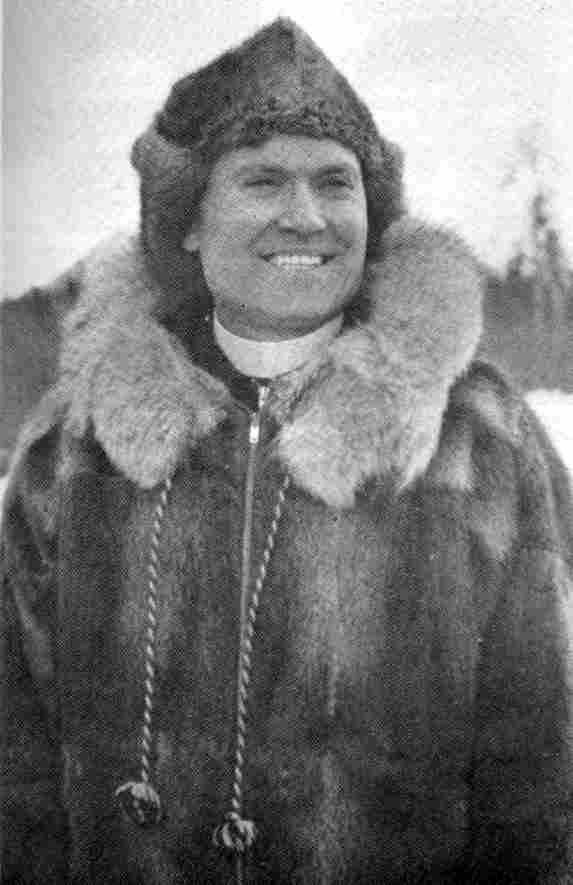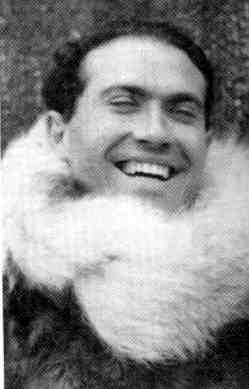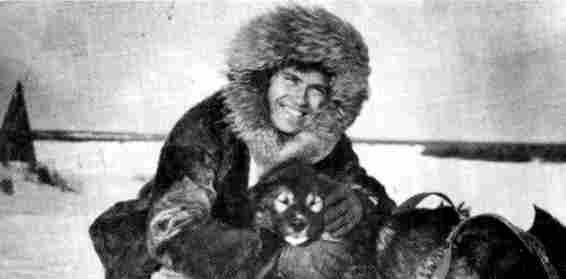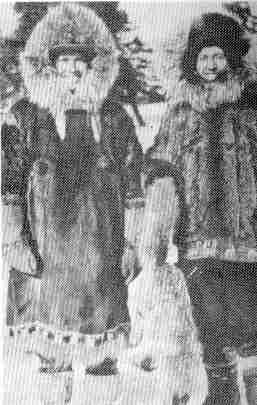![]()
SEGUNDO LLORENTE |
 |
 |
 |
 |
THE LEGENDARY JESUIT MISSIONAIRE IN THE NORTH POLE |
English | Portugués | Español | Japanese |
![]()

At the early age of 17 he answered the call to become a priest, and at 19 went to the missions. He had volunteered for "the most remote and difficult places", and soon after obtained permission to go to Alaska. Forty years among the Eskimos, he traveled thousands of miles and dwell on both sides of the Yukon River. He spent long seasons in Akurulak, Bethel, Kotzebue, and Alakanuc, the first being the place of some of his most exciting memories made famous in the book "Crónicas Akurulakeñas". Segundo Llorente went back to Spain only once, in 1963, a trip design to encourage vocations to the priesthood.
He wrote twelve books about Alaska, all of them in Spanish, even though four years of theology school in Kansas gave him a perfect command of the English language. He was also able to speak sufficient "Eskimo" language to make himself understood among the natives. He wrote thousands of letters, with his deep and habitual flare, inviting the youth of the world to join the priesthood and the rewards of becoming missioners. His letters and essays about life among the Eskimos were published in the magazines "Misiones" and "El Siglo de las Misiones". All this correspondence gave way to the publication of several books being the most important:
"En el País de los Eternos Hielos" (In the Land of Perpetual Ice).
"En las Costas del Mar de Bering" (On the Coast of the Bering Sea).
"Trineos Esquimales" (Eskimo Slates).
"Memories of a Yukon Priest"
"Crónicas Akulurakense" (Akuluraken Chronicles).
"Aventuras en el Círculo Polar" (Aventures in the Polar Circle).
 But the book that excels in compiling
with accuracy an anthology of all the previously cited is the one titled "40 Years in
the Polar Circle", a work prepared y his brother, the Jesuit Fr. Amando Llorente with
the collaboration of Dr. Jose A. Mestre. This book with a delightful prologue and epilog
by the younger Llorente that defines the stature of this "Hercules of God and the
missions’ who never said no to God and who lived a happy life as a priest.
Testimonies about this attitude were attested several times in his writings, particularly
in the following paragraph of the previously cited book: "Neither the Blessed Virgin
nor the angels can do what priests do every day, Christ could have arranged things in many
other ways; but He chose the intervention of the priests. Upon this figure He partakes to
bring salvation to the human race".
But the book that excels in compiling
with accuracy an anthology of all the previously cited is the one titled "40 Years in
the Polar Circle", a work prepared y his brother, the Jesuit Fr. Amando Llorente with
the collaboration of Dr. Jose A. Mestre. This book with a delightful prologue and epilog
by the younger Llorente that defines the stature of this "Hercules of God and the
missions’ who never said no to God and who lived a happy life as a priest.
Testimonies about this attitude were attested several times in his writings, particularly
in the following paragraph of the previously cited book: "Neither the Blessed Virgin
nor the angels can do what priests do every day, Christ could have arranged things in many
other ways; but He chose the intervention of the priests. Upon this figure He partakes to
bring salvation to the human race".
"Among the promises to the devotes of his Sacred Heart we could not miss a most special one for his priests, the promised grace to soften the hearts of those most hardened"
"It seems very common for the Lord having to obey; when I consecrate He must obey; when I absolve He must approve, if there is no faulty impediment; When I baptize He must adopt the creature. He voluntarily submitted Himself to us, as it is often said: "He opted to be at our service".
"In the darkness of the church in Nunajak, He and I, alone, without words, understand each other; we rest and make our heaven on Earth".
"In the great churches of the cities and even in the small towns, there is a tabernacle, so distant from the people that it looks as if one were also far from the Most Holly".
"During my visit to the U.S.A., when I entered those enormous temples it felt as if I was in a public plaza. Here in Nunajak there are no such temples; here, by the altar, I could swear that Jesus can hear the most silent whispers".

"In the mornings I unravel off the blankets like a bear snapping out of his den. I light a candle and jumping into my seal fur boots, always filled with dry grass to make then more comfortable and less cold; I fire the stove and if the water had turn into ice I melt it to be able to wash. Just open a door and walk two steps, there I am, in front of the altar".
"I tell the Lord the same words that the father of the Prodigal son told his older son "You are always with me and all I have is yours", but I seem to hear the other way around: that I am the one always with Him and all his things are mine, and that’s the way it should be, because, my belongings, what good would they make to Him? what is He going to do with my patched-up boots, my ragged garments or my ignorance? On the other hand I can make use of his magnificent attributes: His omnipotence, his kindness and his mercy. Certainly I am always with Him".
Chronology
1906: Born in Mansilla Mayor (Leon), Spain on the 18th of November. Parents: Luis Llorente and Modesta Villa. Brothers: David (1908), Evangelina (1911), Joaquín (1914), Liborio (1916), Amando (1918), María Monserrat (1921), José Luis (1925), and Lucino (1929).
1919: Enters the seminary in Leon, Spain.
1923: On June 16, he enters the Society of Jesus in Carrion de los Condes, Spain.
1926: Studying Humanities in Salamanca, Spain.
1927: Studying Philosophy in Granada, Spain.
 1930:
Travels to the U.S.A.. As a member of the Oregon's Jesuit Province teaches at Gonzaga High
School in Spokane, Washington State.
1930:
Travels to the U.S.A.. As a member of the Oregon's Jesuit Province teaches at Gonzaga High
School in Spokane, Washington State.
1931: Studying Theology in St. Mary’s College in Kansas.
1934: On June 24, he is ordained as a Jesuit Priest. In September he studied theology in Alma, California.
1935: In September he departs for Alaska in a 37 days trip to Akulurak.
1937: Tertionship in Port Townsend, Washington State.
1938: Assigned to Kotzebue.
1941: Named Superior of Akulurak.
1946: On September 21, his father passed away in Spain.
1948: Transferred to Bethel.
1951: Back in Akulurak and Alakanuk.
1952: In October he visited Mexico to attend the Third Congress of Missions in Monterrey.
1953: Visited by his brother Amando Llorente S.J. in Alaska.
1956: On October the third his mother passed away.
1960: Elected as a Representative to the First Congress of the New State of Alaska.
1963: Travels to Spain after having been absent for 33 years. The purpose was to promote vocations to the priesthood.
1964: Transferred to Nome.
1966: Transferred to Cordoba, U.S.A.
1970: Transferred to Anchorage.
1975: After 40 years in Alaska, he is transferred to Moses Lake, Washington State.
1981: Transferred to Pocatello, Idaho.
1984: Chaplain at St. Joseph Hospital in Lewinston, Idaho.
1989: On the 26th of January, he dies in Spokane, Washington and buried on the 30th in Desmet, Idaho.
Website created
by Javier (Spain) and translated by Francisco Javier Casas.